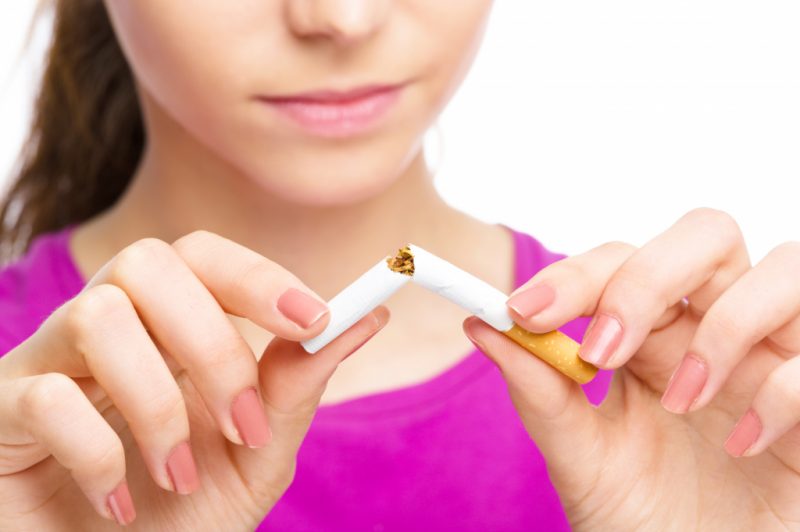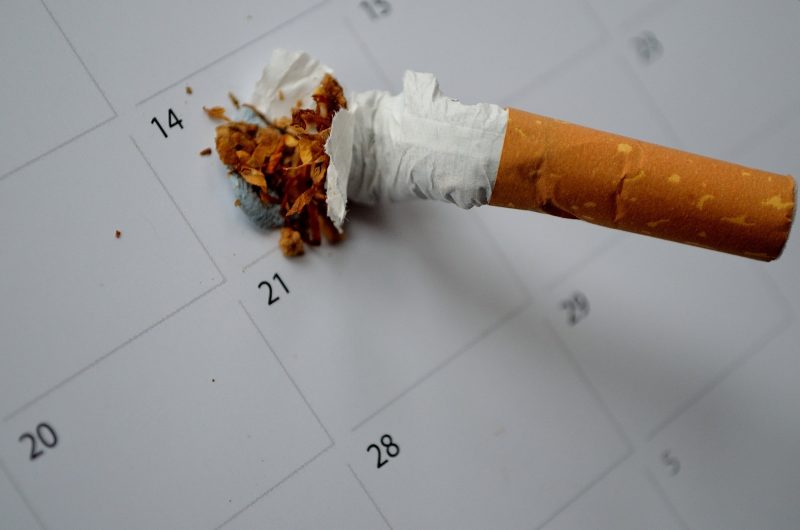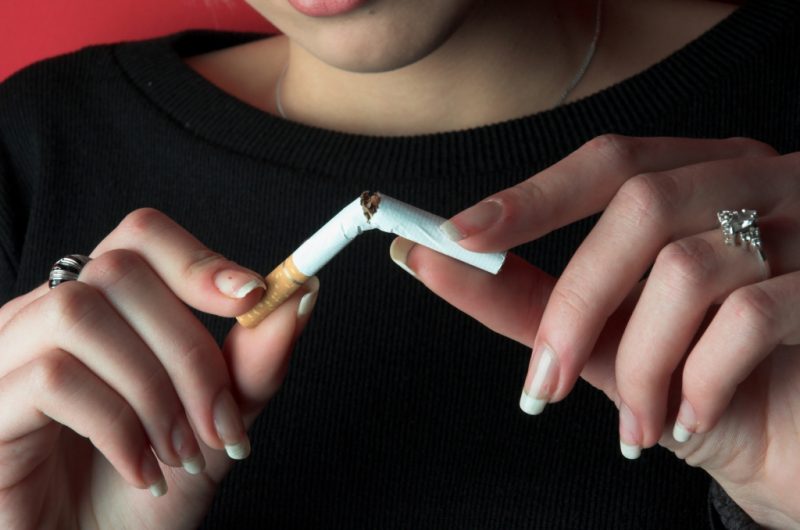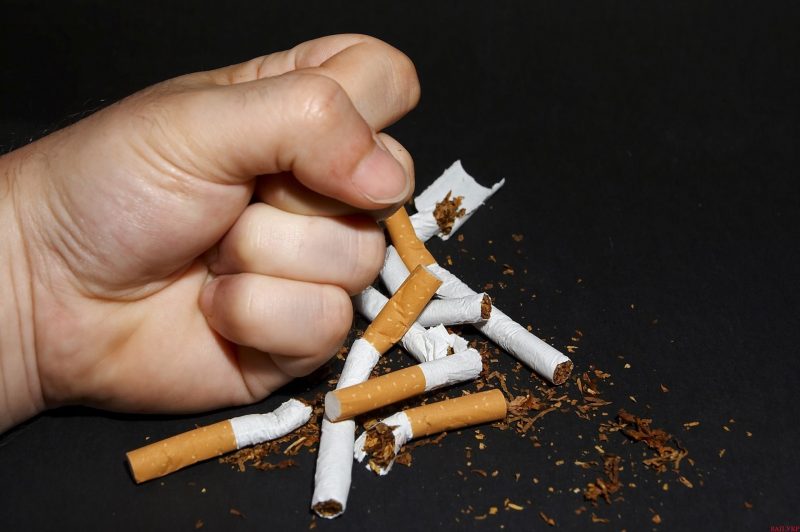Ex-smokers are constantly tempted. But listing all the useful things that happen to the body when you quit smoking is a serious motivation to get rid of addiction. It is necessary to survive in the fight against addiction to cigarettes in order to restore your body.
Material Content:
Positive effects after quitting
The human body is able to recover in a short time due to its compensatory capabilities. Even those who smoke for several decades, have reserves for regeneration. With smoking cessation, the risk of developing many diseases is reduced, including chronic bronchitis, atherosclerosis, thrombophlebitis.

Cigarette smoke is a mixture of hundreds of harmful compounds. Refusal from cigarettes means, first of all, the cessation of the effects of a dangerous "chemical cocktail" on the body.
About 90 substances in the smoke are potential carcinogens that increase the risk of developing oncology. Smokers are also at risk of a heart attack or stroke, living on average 10-14 years less than non-smokers. Components of smoke enter the bloodstream. As a result, blood vessels narrow, pressure jumps, headaches appear.
There is evidence that positive changes come already in the first hours and days without cigarettes. If you stop smoking, then the physiological effect of nicotine on the body lasts 10–28 days. Much more dangerous is psychological dependence.
It is necessary to help the body cope with stress, to abandon the habit of accompanying smoking, communication, mental activity, relaxation and entertainment. These areas of life are good on their own, without tobacco smoke. To distract from thoughts about a cigarette, you can list the health benefits, imagine how much money and time will not be spent on a bad habit.
Unpleasant aspects of smoking cessation
Why is it so hard to quit?
- Nicotine has the ability to temporarily increase the emotional background, which contributes to concentration in difficult situations.
- Pleasant sensations help to bear stress, stress more easily.
- Thanks to the cigarette, feelings of inner peace and satisfaction are achieved.

The smoker, over and over again, strives for those positive effects that he felt at first. Then addiction is formed, more cigarettes are required per day. The biochemical basis of this dependence is the effect of nicotine on acetylcholine receptors. There is a release of other neurotransmitters, including those responsible for the appearance of a feeling of pleasure, a sensation of a surge of strength.
As the components of cigarette smoke enter the bloodstream, the smoker's heart begins to work faster and blood pressure rises. Soon, the concentration of neurotransmitters decreases and discomfort appears.
The effect of nicotine on receptors in a novice smoker lasts about 2 hours, then decreases to 30 minutes, after which discomfort is felt.
An unpleasant aspect of quitting smoking is the development of withdrawal syndrome, or withdrawal. The body lacks nicotinic acid, which increases mental performance (the substance is released during the metabolism of nicotine in the body).
Signs of withdrawal syndrome:
- irritability, aggressiveness;
- trouble concentrating;
- a strong desire to smoke;
- hunger;
- insomnia;
- sweating.
Manufacturers themselves make it difficult for smokers to say goodbye to cigarettes, as they add ingredients that promote nicotine addiction. In case of smoking cessation, deviations in body functions appear. But there are positive changes that are accumulating gradually.
First signs of change
The person who is about to quit smoking should be prepared for the appearance of nicotine withdrawal syndrome. Symptoms disappear after 3–30 days - it’s different for everyone. The main thing is not to panic.

What happens after smoking the last cigarette:
- After 20 minutes, blood pressure and heart rate begin to return to normal.
- Over the next 2 hours, there is an improvement in the blood supply to organs.
- Withdrawal symptoms (desire to smoke, anxiety, increased appetite) may appear.
- After 8 hours, the content of carbon monoxide in the blood drops to normal levels.
- After 12 hours, the oxygen concentration rises.
The absence of nicotine affects the metabolism. The smoker, having refused a cigarette, often snacks, consumes more sandwiches and other food products, sweets, chips, seeds. Extra pounds may appear, which is especially worrying for girls and young women.
Both overeating and a strict diet are contraindicated. It is important to include in your diet more fruits and vegetables, fresh juices, eat often, in small portions. This will satisfy hunger without harming the figure.
Consequences for the body every day and throughout the year
A day after quitting, the risk of developing a heart attack is reduced. But the main consequences for the body are uneven by the day. The most difficult period begins on the third day.

After 3 days, a gradual removal of nicotine from the body begins. It is at this moment that breaking is intensified. Typical symptoms of withdrawal are headaches, nausea, irritability.
After 7-14 days, the physical condition should improve.
For about 5% of former smokers, giving up tobacco is not a physical or psychological problem. “Cigarette addicts” overcome the withdrawal syndrome within 1–7 months.
Within 2-12 weeks, regenerative processes occur in the body:
- pass shortness of breath and an annoying cough, breathe easier;
- susceptibility to infections decreases;
- blood circulation improves;
- increased stamina;
- lungs recover;
- toxins are completely released.
After 12 months without cigarette smoke, the likelihood of developing a heart attack decreases by 2 times. The risk of stroke, coronary heart disease in ex-smokers is the same as in non-smokers. 10 years of “smokeless” life reduce the risk of lung cancer by 50%.
What happens in a woman’s body?
It's no secret that many people find it difficult to quit smoking. The body becomes dependent on nicotine and other components of tobacco smoke, on the process itself. It is especially important for a woman to abandon a bad habit: for her own sake, children's health, family well-being and career growth.

- Smoking during pregnancy increases the risk of severe toxicosis, edema, high blood pressure, and fainting.
- Nicotine intoxication increases the likelihood of abortion by 8-10 times, as well as the death of the child in the perinatal period.
- Nicotine destroys vitamin C, without which most metabolic processes are impossible.
- A child in the womb does not receive all the substances he needs. Tissues and organs are affected, as a result, the baby is born with low weight, physical and mental abnormalities.
The female body responds positively to the rejection of a cigarette. The blood supply to the internal organs increases, which is manifested in the improvement of their functions. Excess mucus in the airways dissolves better and is removed from them. An unpleasant smoker's cough passes that does not decorate either women or men. When walking or running, breathing is easier, the number of colds is reduced, since microbes are better removed from the respiratory tract, the immune system works more reliably and efficiently.
Quitting smoking favorably affects the appearance: the skin becomes fresher, the hair acquires a lively shine and strength (if they are properly looked after).
Improving the supply of blood to the brain, normalizing blood pressure have a positive effect on the well-being of women. Thanks to the restoration of nerve endings, the taste and smells of food, aromas of perfumes and flowers are more subtly felt.
Is it harmful to quit smoking abruptly?
Scientists used positron emission tomography to understand the processes taking place in the brain. It turned out that the neurobiological changes in smokers are almost the same as in heroin addicts. Therefore, technologies and programs for the rehabilitation of people suffering from this addiction have been created by analogy with the treatment of drug addiction and gambling addiction.

According to surveys conducted in different countries, three out of 10 smokers are trying to "tie up". However, the majority fails, and the relapse rate (95%) confirms this. Therefore, it is necessary to prepare for the fact that at first there will be problems.
One way to overcome difficulties is to make a list of the pros and cons, pluses and minuses. If the decision to quit smoking is made, then you should consider how to minimize the symptoms of withdrawal. The symptoms of abstinence are taken aback precisely by those who quit smoking abruptly.
There are drugs in the form of patches, inhalers, chewing gum containing nicotine.
The substance enters the body, has a weak effect, which helps with withdrawal.
Antidepressant drugs and nicotine blockers also reduce withdrawal symptoms.
What can facilitate the recovery process?
To compensate for the harm caused by long years of smoking, a diet rich in antioxidants, vitamins A, E, C. will help.You can take appropriate biological food additives if any products containing the necessary substances to cleanse the body are not available.

Researchers in the West have found a connection between eating tomatoes, apples and bananas with the quick recovery of the ex-smoker. Soy products can also help - soy contains anti-inflammatory ingredients necessary to protect cells from the harmful effects of nicotine.
The main thing is motivation, convincing oneself of the necessity and benefits of quitting smoking. This may be a desire to save money, preserve health, and not harm others.
Smoking is like slavish addiction to cigarettes. According to statistics, only 3-6% of smokers cope without nicotine without drugs, courses and other outside help. All the rest of the willpower is not enough, they require replacement, behavioral and other types of therapy.
Psychologists and psychotherapists have developed special smoking cessation programs. The group form of treatment eliminates the void in which a “cigarette addict” may end up. The most promising direction is combination treatment, which includes methods of self-motivation, behavioral therapy and medications to alleviate withdrawal symptoms.












